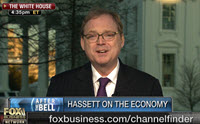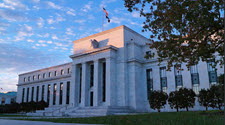Nearly a month into the partial government shutdown, the impasse over funding of a border wall on the Mexican border continues with no sign that an agreement between President Trump and Congress is near. (Axios, Jan. 16
 |
White House Council of Economic Advisers Chairman Kevin Hassett this week doubled the estimate of how the government's partial shutdown is reducing economic growth. The initial cost to the economy, estimated at 0.1 percentage point in growth every two weeks, was revised to 0.13 percentage point every week. ( Fox interview , Jan. 15 /Forbes, Jan. 16 / Vox, Jan. 18 ) |
- White House Council of Economic Advisers Chairman Kevin Hassett this week doubled the estimate of how the government's partial shutdown is reducing economic growth. The initial cost to the economy, estimated at 0.1 percentage point in growth every two weeks, was revised to 0.13 percentage point every week. (Forbes, Jan. 16 and Vox, Jan. 18)
- Another potential impact of the shutdown may affect landlords who rent to the federal government. According to Bloomberg Government, the General Services Administration (GSA) usually issues the government's rental obligations, but with furloughed staff unable to process the checks, the payments may stop. "The GSA leased more than 190 million square feet in nearly 7,000 buildings nationwide at the start of its 2018 fiscal year, representing roughly $5.6 billion in annual rent payments," BGov reported Jan. 15. The GSA states it "is aware of concerns from the Lessor community regarding GSA's ability to make timely rent payments," and "is diligently exploring all available options."
- Federal Reserve Chairman Jerome Powell said last week that if the shutdown is prolonged, it would start to noticeably affect the economy. "If we have an extended shutdown, I do think that would show up in the data pretty clear." Powell added that the full economic impact of closed government agencies is difficult to track because data usually provided by the Commerce Department is not currently available, due to the shutdown. (Economic Club of Washington video interview at 13:30 and The Hill, Jan. 10)
- The results of a Federal Reserve survey of the 12 regional Fed banks through Jan. 7 known as "the beige book" were released this week, showing a generally positive picture for the U.S. economy but revealing an undercurrent of worry. (WSJ, Jan. 16)
 |
The Fed' s " beige book " shows a generally positive picture for the U.S. economy but reveals an undercurrent of worry. (WSJ, Jan. 16) |
- According to the Fed report, "Outlooks generally remained positive, but many Districts reported that contacts had become less optimistic in response to increased financial market volatility, rising short-term interest rates, falling energy prices, and elevated trade and political uncertainty."
- The report adds that "A number of Districts reported rising home prices, while prices for commercial and industrial space either increased or were flat" while noting that U.S. labor markets were shown to have tightened as businesses struggled to find workers at any skill level. (Reuters, Jan. 16)
The Fed's Open Market Committee will meet next on Jan. 29-30, the same time as The Roundtable's State of the Industry Meeting in Washington.

